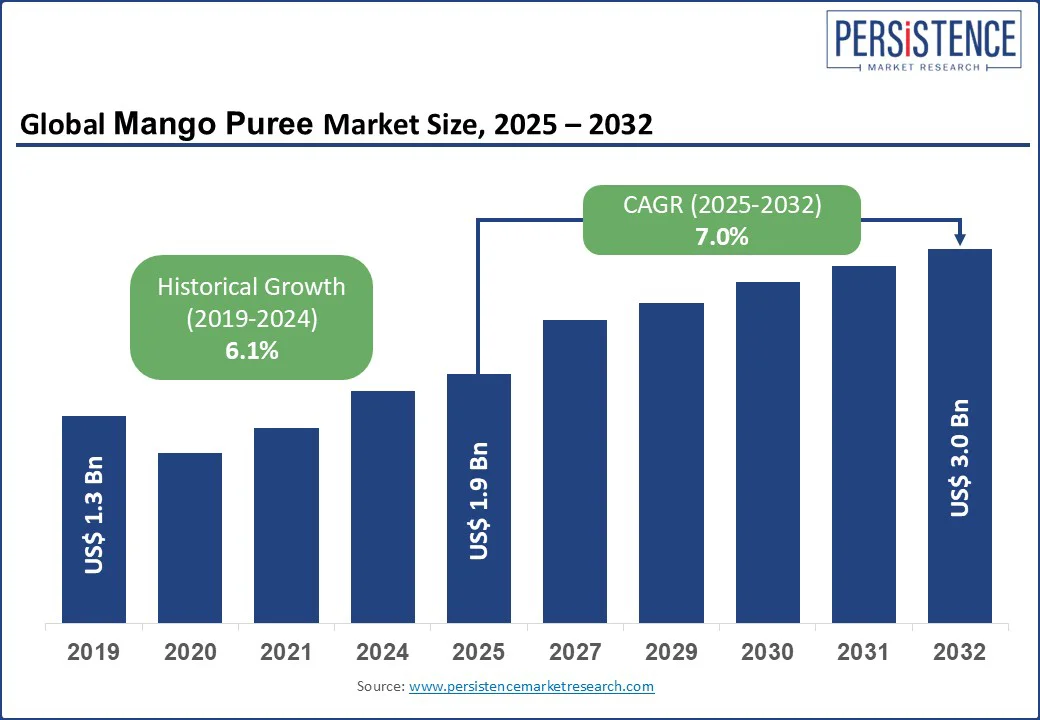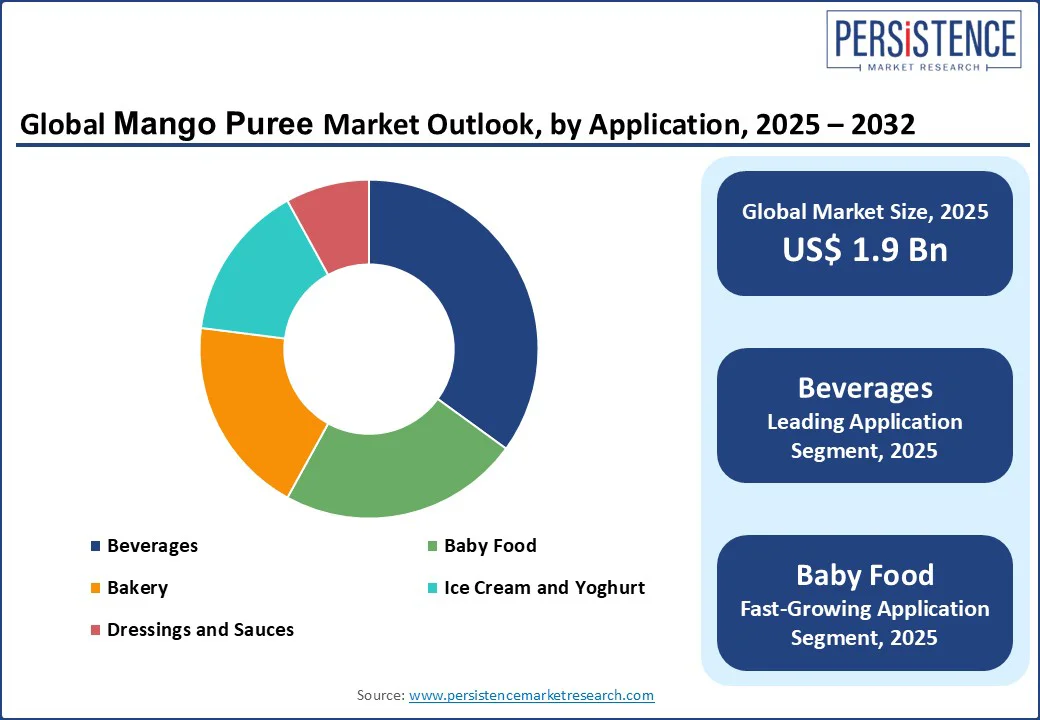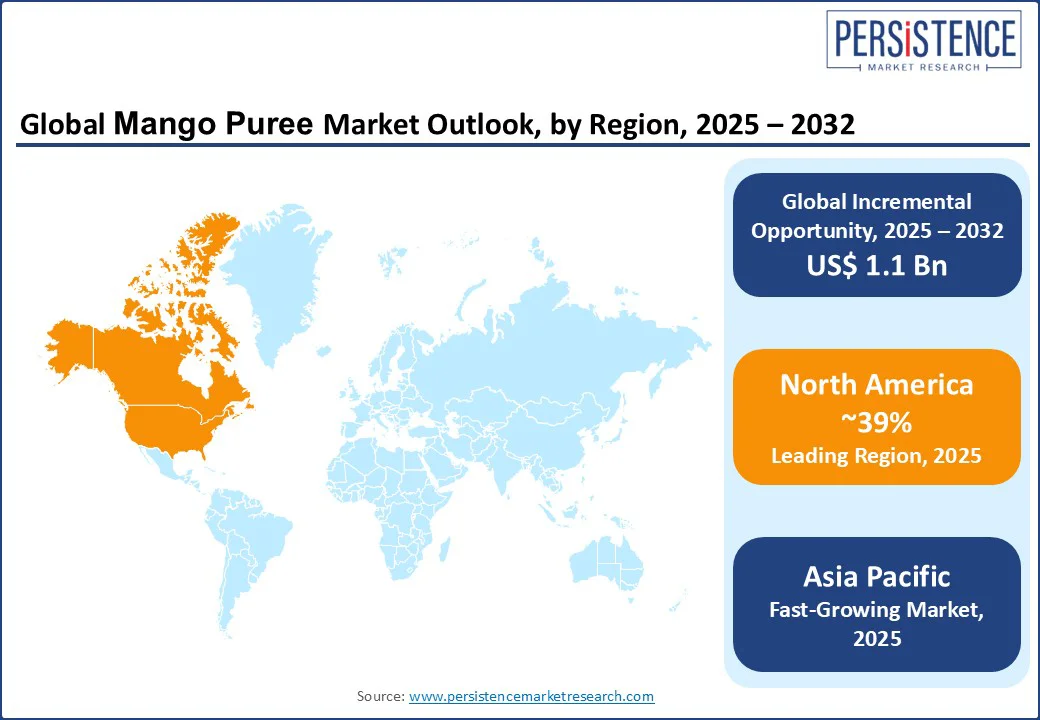ID: PMRREP32404| 183 Pages | 19 Aug 2025 | Format: PDF, Excel, PPT* | Food and Beverages

The global Mango Puree Market is projected to grow from US$ 1.9 Bn in 2025 to US$ 3.0 Bn by 2032, registering a CAGR of 7.0% during the forecast period from 2025 to 2032.
The industry has experienced robust growth, driven by increasing consumer demand for natural and healthy food ingredients, the rising popularity of tropical fruit flavors in various food and beverage applications, and the growing adoption of mango puree in both developed and emerging markets.
The sector is propelled by the versatility of mango puree as a key ingredient in beverages, baby food, and other processed food products, alongside the global shift toward organic and clean-label products that cater to health-conscious consumers.

Key Industry Highlights:
|
Global Market Attribute |
Key Insights |
|
Mango Puree Market Size (2025E) |
US$ 1.9 Bn |
|
Market Value Forecast (2032F) |
US$ 3.0 Bn |
|
Projected Growth (CAGR 2025 to 2032) |
7.0% |
|
Historical Market Growth (CAGR 2019 to 2024) |
6.1% |
The rising demand for natural and healthy food ingredients is a key driver for the mango puree market. Consumers are increasingly seeking clean-label, minimally processed products free from artificial additives, preservatives, and synthetic sweeteners. Mango puree, being rich in vitamins, antioxidants, and natural sugars, aligns perfectly with these preferences. Its versatility in applications such as smoothies, juices, baby food, dairy alternatives, bakery items, and confectionery further boosts its appeal. The growing popularity of plant-based and vegan diets has also amplified demand, as mango puree serves as a natural flavor enhancer and sweetener in dairy-free and functional beverages.
For instance, in 2024, several global beverage brands launched mango-based smoothies and fortified juices to cater to the health-conscious consumer segment. Health-conscious lifestyles, combined with the trend toward exotic and tropical flavors, are fueling sustained growth in mango puree consumption worldwide.
The mango puree market faces significant challenges due to fluctuating raw material availability, primarily driven by seasonal variations, climate change, and unpredictable weather patterns. Mangoes are highly sensitive to changes in temperature, rainfall, and pest infestations, which can lead to reduced crop yields and inconsistent quality. Factors such as droughts, floods, and cyclones in key mango-producing regions such as India, Mexico, Thailand, and the Philippines can disrupt supply chains, leading to shortages and price volatility.
Moreover, mango harvesting is labor-intensive, and workforce shortages during peak seasons can further impact availability. Post-harvest losses due to inadequate cold storage, transportation infrastructure, and processing facilities in some regions exacerbate the issue, causing wastage and reduced profitability.
For instance, in 2023, erratic monsoon rains in India, a leading global mango producer, resulted in a 15% drop in production, significantly affecting puree exports.
Similarly, in 2022, unseasonal cyclones in the Philippines damaged large mango orchards, cutting yields by nearly 20% and disrupting regional supply chains. These fluctuations not only strain relationships with global buyers but also make it challenging for manufacturers to maintain consistent production volumes, pricing stability, and long-term contracts. Consequently, the industry must invest in sustainable sourcing strategies and supply chain resilience to mitigate these risks.
The growing consumer shift toward organic and sustainable food products presents a significant opportunity for the mango puree market. Increasing health awareness and environmental concerns are driving demand for organically cultivated mangoes, free from synthetic pesticides, fertilizers, and genetically modified organisms.
Organic mango puree appeals to health-conscious consumers, especially in developed markets such as North America and Europe, where clean-label and eco-friendly products are highly valued. Sustainable farming practices not only enhance soil health and biodiversity but also align with global sustainability goals, improving brand image and marketability.
For instance, several mango processors in India and Mexico are partnering with farmers to adopt organic certification and fair-trade practices, ensuring traceability from farm to table. For instance, in 2024, an organic mango cooperative in Mexico secured export deals with premium juice brands in the U.S. and Europe, boosting revenue by over 20%. The premium pricing of organic mango puree offers higher profit margins, while eco-conscious packaging and reduced carbon footprints further attract environmentally aware buyers. As organic food adoption continues to rise globally, the sector stands to benefit from robust growth in this segment.
Conventional mango puree dominates the domain, expected to account for approximately 63% of the industry share in 2025. Its dominance stems from its cost-effectiveness, widespread availability, and established use in large-scale food and beverage production. Conventional mango puree is produced from commercially grown mangoes, which are more abundant and less expensive than organic varieties, making it a preferred choice for manufacturers targeting price-sensitive markets.
The organic mango puree segment is the fastest-growing from 2025 to 2032, driven by increasing consumer demand for organic and clean-label products. Organic mango puree, produced without synthetic pesticides or fertilizers, appeals to health-conscious consumers and aligns with global sustainability trends. The rise of organic certifications and improved organic farming practices in countries such as India and Mexico is accelerating the adoption of organic mango puree, particularly in premium food and beverage applications.
Beverages led the mango puree market, holding a 35% share in 2025. The segment’s dominance is driven by the global popularity of fruit-based drinks, including smoothies, juices, and flavored water, where mango puree serves as a key ingredient for its natural sweetness and vibrant flavor. Major beverage companies, such as PepsiCo and Coca-Cola, rely heavily on mango puree for their tropical-flavored product lines, contributing to the segment’s growth.
The baby food segment is the fastest-growing, fueled by increasing demand for natural and nutritious infant nutrition products. Mango puree’s high vitamin content and smooth texture make it an ideal ingredient for baby food formulations. Rising awareness of the benefits of organic and fruit-based baby food, coupled with growing disposable incomes in emerging markets, is driving the rapid adoption of mango puree in this segment.
Indirect sales dominate the mango puree market, accounting for over significant of revenue in 2025. This segment includes sales through supermarkets, hypermarkets, and online retail platforms, which offer wide accessibility to consumers. The growth of e-commerce platforms, such as Amazon and Walmart, has significantly boosted indirect sales of mango puree-based products, particularly in urban markets.
Direct sales are the fastest-growing segment, driven by increasing B2B transactions between mango puree manufacturers and food processing companies. Direct sales channels enable manufacturers to offer customized products and bulk discounts, appealing to large-scale buyers in the food and beverage industry. The rise of contract manufacturing and private-label brands further supports the growth of direct sales.

North America is projected to hold the largest share of the global mango puree market in 2025, accounting for approximately 39% of total revenue. This dominance is fueled by strong consumer demand for processed fruit products, particularly those that align with health-conscious and clean-label trends. The region’s preference for natural, nutrient-rich, and minimally processed foods has positioned mango puree as a popular ingredient in a wide range of applications, including smoothies, juices, baby food, dairy alternatives, bakery products, and functional beverages. The increasing adoption of plant-based and vegan diets further supports this growth, as mango puree serves as a natural sweetener and flavor enhancer in dairy-free and non-GMO products.
The region benefits from advanced food processing infrastructure, well-established distribution networks, and high purchasing power, enabling wider product availability across retail and foodservice channels. For instance, beverage brands in the U.S. and Canada are increasingly incorporating mango puree into premium juice blends and health-focused drink lines to meet growing consumer demand for tropical flavors with functional health benefits.
Europe holds a significant share driven by strong sustainability initiatives, advanced food processing capabilities, and growing demand for tropical fruit ingredients. Leading countries include Germany, the UK, and France. Germany benefits from its robust food and beverage industry and leadership in organic and sustainable sourcing, with companies such as Döhler GmbH investing heavily in certified organic mango puree. The UK’s market is bolstered by the rapid growth of health-conscious consumer trends and demand for natural ingredients in beverages and baby food. France’s market is supported by significant investments in clean-label and premium food products.
The EU’s stringent regulations, such as the EU Organic Regulation, drive the adoption of organic mango puree, though compliance with complex certification processes poses challenges. Europe’s mango puree market is projected to grow steadily from 2025 to 2032, supported by innovations in sustainable processing and increasing consumer preference for natural products.
The Asia Pacific region is expected to witness the fastest growth in the global mango puree market during the forecast period, fueled by rising consumption across diverse food and beverage applications. Countries such as India, China, Thailand, and the Philippines are key contributors, supported by abundant mango production and expanding processing capacities.
The region’s large and growing population, coupled with increasing disposable incomes, is driving demand for value-added fruit products, including smoothies, juices, baby food, and confectionery items incorporating mango puree. Moreover, the popularity of tropical flavors and the cultural significance of mangoes in many Asian cuisines further enhance market growth. Rapid urbanization, improvements in cold chain infrastructure, and expanding exports from the region are also accelerating the adoption of mango puree, both domestically and in international markets.

The global mango puree market is characterized by strong competition, regional strengths, and a mix of global and local manufacturers. In developed regions such as North America and Europe, large firms such as Döhler GmbH and AGRANA Beteiligungs-AG dominate through scale, advanced processing technologies, and established partnerships with food and beverage giants. In the Asia Pacific, rapid growth in food processing and exports attracts significant investments from both local players such as Aditi Foods India Pvt. Ltd. and international companies.
The Mango Puree market is projected to reach US$ 1.9 Bn in 2025.
The surge in demand for natural and healthy food ingredients and the growing popularity of tropical flavors are key drivers.
The Mango Puree market is poised to witness a CAGR of 7.0% from 2025 to 2032.
Advancements in organic and sustainable food production technologies are a key opportunity.
Döhler GmbH, Kiril Mischeff, Tree Top Inc., AGRANA Beteiligungs-AG, and ITC Limited are key players.
|
Report Attribute |
Details |
|
Historical Data/Actuals |
2019 - 2024 |
|
Forecast Period |
2025 - 2032 |
|
Market Analysis Units |
Value: US$ Bn, Volume: As Applicable |
|
Geographical Coverage |
|
|
Segmental Coverage |
|
|
Competitive Analysis |
|
|
Report Highlights |
|
|
Customization and Pricing |
|
By Nature, Type
By Application
By Distribution Channel
By Region
Delivery Timelines
For more information on this report and its delivery timelines please get in touch with our sales team.
About Author